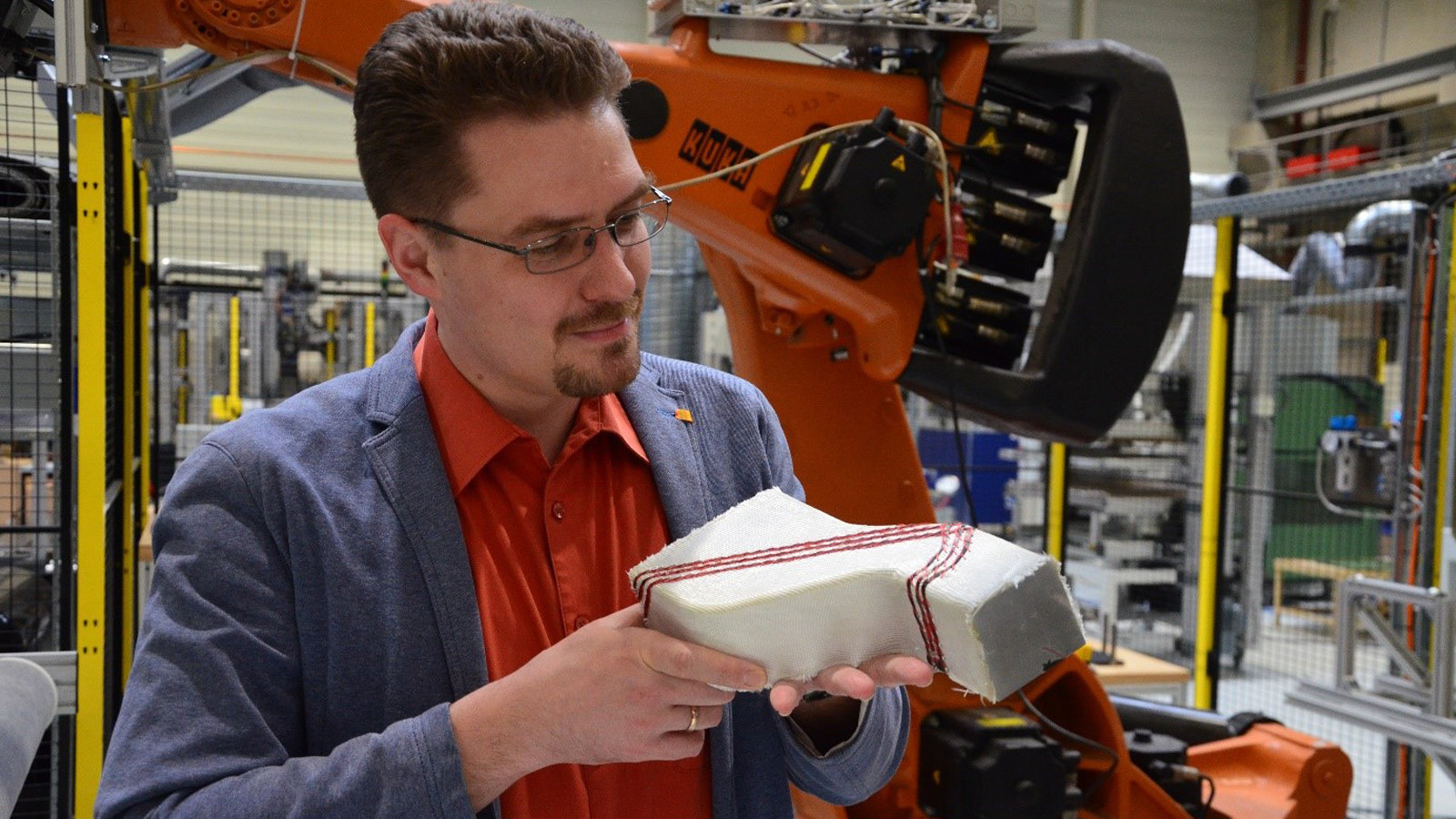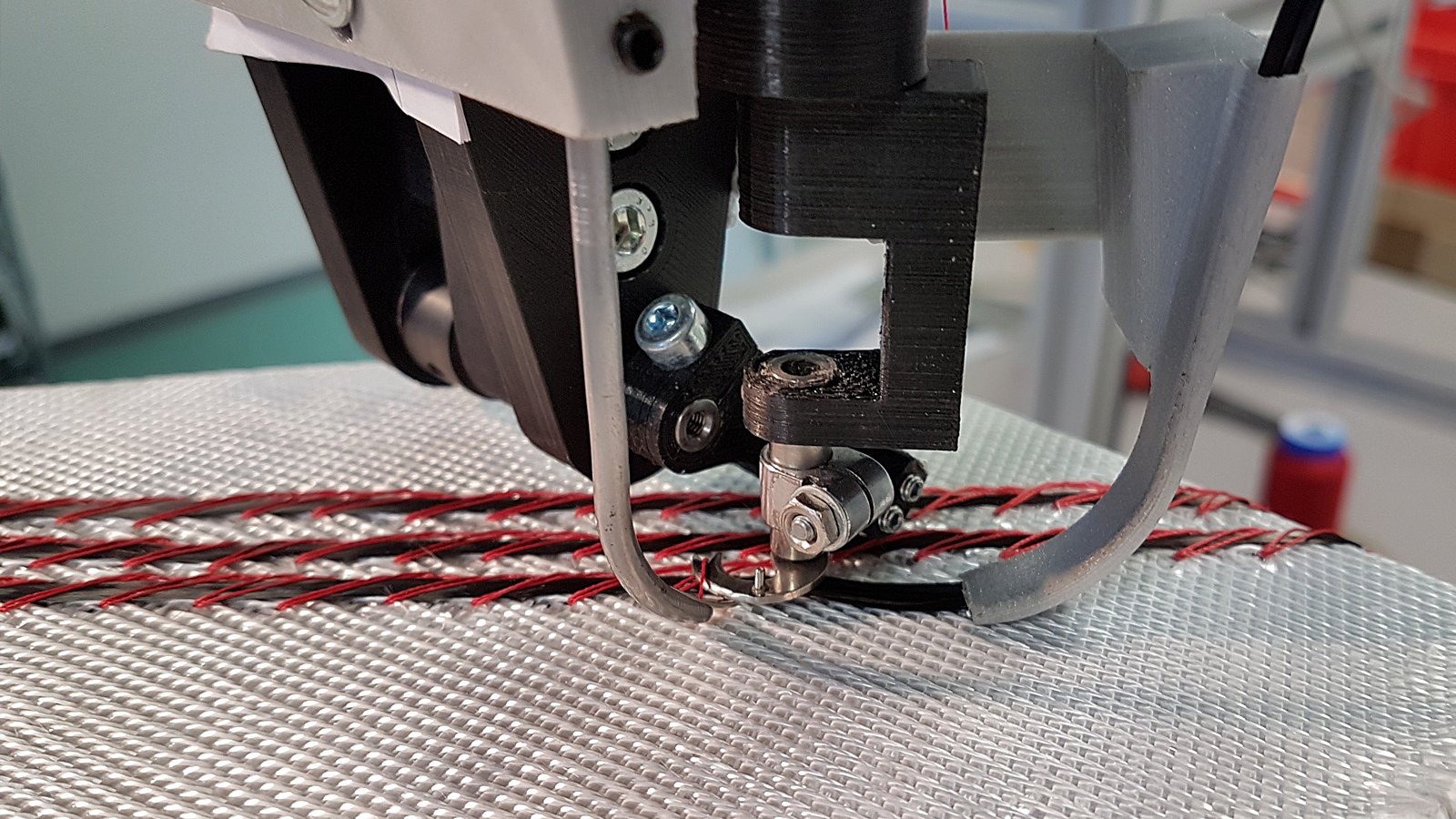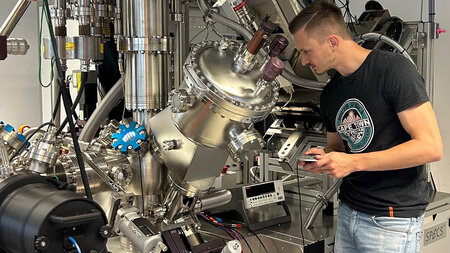The perfect thread guide
Researchers at Chemnitz University of Technology, in cooperation with Pfeil GmbH, are developing a new type of blind stitch sewing technology for the production of high-performance lightweight components
-

Stefan Demmig, researcher at Chemnitz University of Technology, shows a demonstrator manufactured using the newly developed blind stitch sewing technology. Photo: Diana Schreiterer -

Thanks to the development of the sewing head by Pfeil GmbH, the load-path-adapted fibre reinforcement can now be draped automatically and then fixed in place by means of a robot-guided needle using blind stitching. Photo: Stefan Demmig
The use of textiles as fibre reinforcement in lightweight construction is well established, as successful application examples from the automotive and mechanical engineering industries, medical technology and many other sectors show. Modern wide-bodied aircraft, wind turbines or the prostheses of amputee athletes would be inconceivable without the use of fibre-plastic composites. The key benefit of using textiles in material composites is that they offer stability without significantly increasing the weight of a component. “The direction of the fibres is of critical importance for the load-bearing capacity of a textile-reinforced component, as it gives the material the necessary stability. In the longitudinal direction of the fibres, for example, textiles are highly stressable, in the transverse direction, however, they are considerably less powerful,” explains Stefan Demmig, research associate at the Department of Lightweight Structures and Polymer Processing at Chemnitz University of Technology. Now, the university's researchers have succeeded in developing a new way of processing textile materials in cooperation with the company Pfeil GmbH from Mühlau in Saxony. For this purpose, they have designed a novel, robot-guided blind stitch sewing system for one-sided sewing. This new technology enables automatic positioning of the fibres into the all-important load-adapted position, which guarantees maximum stability - not only in 2D, but also in 3D. Until now, 3D components have been manufactured from 2D semi-finished textile products and thus in a much more labour- and resource-intensive way. The new process eliminates this intermediate step entirely.
For this textile reinforcement of a future lightweight component, bundles of carbon fibres, so-called rovings, are placed in the appropriate position and sewn onto a special glass fibre fabric with a thin auxiliary thread. The fabric and the roving must be fixed to a core in order to develop the desired three-dimensional shape, which means that the sewing machine only has access from one side. Conventional machines, however, require access from below and above for sewing. The project team therefore designed a system that allows the textile to be embroidered from only one side using a curved needle. In this way, the rovings are fixed directly onto the workpiece with a polyester thread using blind stitching. Thanks to this new system, the commands for robot control can be derived directly from the design data. As a result, the production of the reinforcing structure is fully automatic and has a crucial advantage: design, simulation and production are brought in line. This saves resources and improves the manufacturing process and its results.
“For production, this means far fewer fibre interruptions and an automatic alignment of the fibres according to the load path, so that they no longer depend on manual draping. As a result, these fibre-plastic composite components not only have a significantly higher performance, but also save expensive materials and thus costs. The complex technology behind the new process does not make the components equally suitable for mass production, but in return high-performance products are created. It is well suited for applications that push materials to their limits, such as in the aerospace industry,” Stefan Demmig predicts.
Based on the initial developments, the engineer's future research aims to sew the rovings using a thread made of carbon or glass fibres instead of using polyester, as has been the case until now. This should lead to an increase in the thickness of the material and thus to an increase in stability. In future studies, the project partners also plan to examine the special binding adhesive that bonds the mould core to the textile during the sewing process as well as the release agent that removes it. This process involves the use of a so-called binder powder, which has been specially developed for the aerospace industry, in order to replace the materials previously used with an adhesive-release agent combination that is approved for use in aviation.
A patent for this technology has already been granted by the German Patent and Trademark Office (DE 10 2015 110 855 B4 2019.12.05) and paves the way for future applications and further developments.
For further information, please contact Dipl.-Ing. Stefan Demmig, research associate at the Department of Lightweight Structures and Polymer Technology, phone 0371 531-38387, e-mail stefan.demmig@mb.tu-chemnitz.de
(Authors: Peter Jacobi and Diana Schreiterer / Translation: Eva Laurie)
Matthias Fejes
12.03.2020




